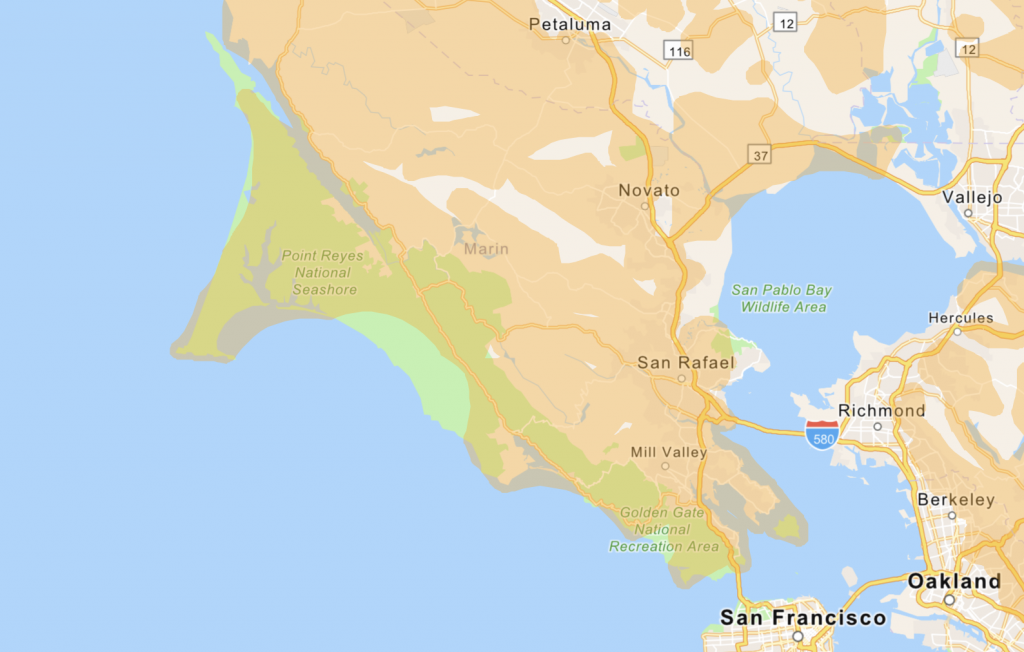
SAN RAFAEL, CA – Pacific Gas & Electric Company (PG&E) has notified the County that it may activate its Public Safety Power Shutoff (PSPS) protocols in response to a high wind event and Red Flag Warning. At 7:30am this morning, PG&E said it could potentially initiate a planned power shutoff in parts of Marin County between 1pm and 5pm on October 26th, 2019. PG&E estimated that 86,813 meters locations within Marin would be affected by a possible PSPS. The duration of the shutoff is unknown and will be determined by PG&E.
The Marin County Office of Emergency Management is putting into motion its Electrical System De-energization Response Plan. Additionally, it is coordinating with nearby response partners in monitoring the power situation. The Emergency Operations Center will be activated in the event of the Public Safety Power Shutoff.
“We are being proactive and mobilizing our resources due to the potential power loss and increased fire threat,” said Supervisor Kate Sears, President of the Marin County Board of Supervisors. “Public safety is our No. 1 priority, and we will focus our efforts to ensure the safety and security of our residents – especially those with access and functional needs whose health could be impacted by the loss of power.”
The planned duration of the possible shutoff is unknown and will be determined by PG&E. “We’ll work alongside PG&E’s staff to communicate updates using all our outreach tools,” Supervisor Sears said. PG&E is monitoring weather patterns and said it will provide updates to customers and the County of Marin as additional information is available. Residents and businesses can access updated PSPS information from PG&E online at www.pge.com/pspsupdates.
All questions regarding PSPS events and extended outages should be directed to PG&E via their website and (866) 743-6589. Please only call 9-1-1 if you are experiencing a medical or life-threatening emergency.
For non-emergency information and referrals, contact 211 Bay Area by calling 2-1-1 or text MARINSHUTOFF to 898-211 (or MARINAPAGON to 898-211 for Spanish speaking residents). In addition, vulnerable adults can check Marin County Health & Human Services’ online community resource guide for additional information.
911 VS 211
- Call 911 for an immediate response from police, fire department, or emergency medical service teams, for crimes happening now, suspicious activity, and life-threatening emergencies.
Call 211 to find resources on non-emergency event information like community resource center locations, power shutoff area updates, and other social services.
Emergency Management officials remind residents and visitors that it is important to have a plan to adjust daily routines to one without PG&E power. FEMA recommends the following steps:
Stay informed
- Sign up to receive safety information on Nixle by texting your ZIP code to 888-777.
- Sign up for AlertMarin notifications to receive information on immediate threats to personal safety or property, tailored to an address of your choosing.
- Sign-up for PSPS Zip Code Alerts by texting ENROLL to 97633 or by calling 1-877-9000-PGE.
- Update contact information with PG&E at www.pge.com/mywildfirealerts or by calling 1-866-743-6589.
Review plans
- Identify several evacuation routes for your location in case roads are blocked. Tell someone out of the area which routes you plan to use.
- Keep vehicles fueled and ready in case of an evacuation.
- Make a list of what you’ll want to take with you if you leave your home quickly. Consider the Five P’s of Evacuation: People/Pets; Prescriptions; Papers; Personal Needs; Priceless Items.
- Talk to a medical provider about a power outage plan for medical devices powered by electricity and refrigerated medicines. Take stock of batteries and other alternatives to meet your needs when the power goes out.
- Take inventory of available supplies such as food, water, clothing, and flashlight batteries.
- Have some cash available in case retail point-of-sale devices are unable to accept credit cards during an outage.
- Check thermometers in refrigerators and freezers during an outage. Dispose of perishable food if the appliance temperature reaches 40 degrees or higher for an extended period.
- Keep mobile phones and other electric equipment charged.
- Know how to manually open electric garage doors and gates
Power Outage Safety Tips
- Use a cell phone or hard-wired phone. Cordless phones do not work without electricity.
- Use battery-operated flashlights, not candles, which pose a fire hazard.
- Unplug or turn off all electric and heat-producing appliances (e.g. air conditioners, washers and dryers, ovens, stoves, irons) to avoid overloading circuits. Overloaded circuits can be a fire hazard once power is restored.
- Unplug televisions and computers that were in use when the power went out.
- Leave a single lamp on to alert you when power returns.
- Keep refrigerator and freezer doors closed, and place extra containers of ice inside to preserve food. A full freezer will remain colder longer.
- Notify your alarm company if you have an alarm system. Equipment can be affected by outages.
- Turn your appliances back on one at a time when conditions return to normal.
- Reset clocks, thermostats and other programmed equipment after power is restored.
Preparing for a Power Outage
- Keep important numbers (e.g. hospital, fire department, police, friends, relatives) near the phone.
- Keep battery-operated flashlights and radios and extra batteries on hand.
- Gather non-perishable food that doesn’t require cooking, as well as a manual can opener.
- Freeze water-filled plastic jugs to make blocks of ice. Place them in the fridge and freezer to help prevent food from spoiling.
- If you have a generator, make sure a licensed electrician properly installs it. Improperly installed generators pose a significant danger to our crews.







